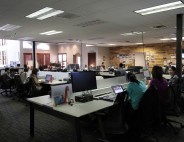
Innovative Ideas Saving the Urban Core
03 Aug, 2015
Caption: AeroFarms corporate headquarters and world’s largest indoor vertical farm in Newark, New Jersey. Rendering: AeroFarms
By David Hodes
Organizations change the status quo of city cores.
“I am not in this to build a farm. I am in this to change the world”
That’s David Rosenberg, CEO of AeroFarms LLC, the business development visionary and serial entrepreneur behind one of the most innovative farming installments in the world, which doubles as one of the most innovative ways to revitalize an urban core of a city.
Rosenberg’s farm grows 200 different kinds of leafy greens with no soil, no sun and 75 percent less water than a similar growing operation in a greenhouse and 50 percent less fertilizer. And because of the spectrum of light used (no green), bugs are not attracted to the plants and no pesticides need to be used.
This aeroponic vertical farm will be built inside of a converted steel factory in the heart of Newark, New Jersey, which will also be the world headquarters for AeroFarms. The company will be the anchor tenant of a 69,000-square-foot development in the center of the four-square-mile, multi-ethnic Ironbound community in the East Ward of the city of Newark.
The building sat vacant for years before Rosenberg, along with the developer, Ron Bates Holding Group, and investment partners — Goldman Sachs Urban Investment Group, Prudential Financial, Inc., the city of Newark and the New Jersey Economic Development Authority (NJEDA) — invested $30 million to redevelop this industrial site. The first phase of the project is expected to open later this year.

The Cedar Fairmount business district is known as the Gateway to Cleveland Heights. In the early 1900s, real estate developers turned this area into the first planned neighborhood shopping district in the Heights. The Northeast Ohio First Suburbs Consortium membership represents 37 percent of Cuyahoga County’s population. Photo: City of Cleveland Heights
It’s a demonstration project of a novel automated way to repurpose an industrial site in the core of a city that pays off in something no industrial site in the middle of the downtown of a major city has done before — edible produce — lots of edible produce. As in 2 million pounds of leafy greens a year.
“What this farm needs are seeds, nutrients, water, and a light spectrum which can be delivered by LEDs,” Rosenberg says. “You need oxygen and you need to control a certain humidity and temperature range, and a certain range of pH. But all of these can be controlled anywhere. This type of farm can be done anywhere.”
Seedlings are placed on racks, loaded on conveyor belts that rise vertically, slowly, through a 21-day process of watering and spectrum exposure, then are harvested at the end of the cycle.
The level of sophistication to operate the vertical farm safely to produce a good yield is all about managing a complex set of data analytics, something others who have tried similar high-tech grows have misunderstood. “Biology is tricky,” Rosenberg says. “We have on our team structural engineers, mechanical engineers, lighting engineers, electrical engineers and horticulturists. And data scientists working on a lot of data analytics. It really takes a lot of expertise, a multitude of disciplines to get something working in concert with the building.”
There are 22 standard operation procedures for the vertical farm. “The food processing is automated, the seeding is automated, the harvesting is automated, the packaging is automated,” Rosenberg says. “There is just an incredible amount of thoughtfulness put in to this operation. We are taking over 10,000 data points from seed to harvest, and by the time we are fully up and operating I believe that we are going to have over 8 million data points a day. And I believe that number is going to actually double by the end of the year. No one else in the world is doing this.”
Why Newark? “The city has been great to me, and the state has been great to me and I just wanted to give back,” Rosenberg says. “And Newark is close to a lot of major markets — like New York — and a big customer base.”
NJEDA took the leap to partner with Rosenberg in what could be considered a risky business venture.
But the organization felt insulated from financial disaster because all of their incentive programs are performance based, says Tim Lizura, president and COO of NJEDA. “It may be a novel technology, but because our incentives happen annually each year after the company has performed that year’s obligations, we don’t have that risk,” he says.
ACADEMIA LEARNS TO LEAD
The effort to revitalize Newark doesn’t end with this one-of-a-kind development. Lizura says that another example of the revitalization of the urban core of Newark is the connection between Rutgers University-Newark campus and downtown.
Rutgers is committed to spending $25 million to put its arts program downtown in the vacant Hahne & Co. department store, which is also soon to be home to Whole Foods, office space and rental apartments.
The university has also committed to construct new housing for graduate students and mixed use development along the New Street corridor to downtown Newark. “And that is the biggest development I have seen in my 20 years here,” Lizura says. “That corridor connecting the university to downtown is really a game changer.”
Partnerships between the higher education system and economic development groups is also fueling revitalizations in Reno, Nevada.
The thinking follows that the best way to revitalize downtown Reno is to integrate the University of Reno-Nevada (URN) into the business core. “We are looking actively to attract startups, and our downtown is the key to that, accelerating our ability to attract more technology to this region,” says Mike Kazmierski, president and CEO, Economic Development Authority of Western Nevada (EDAWN), says. “That is connected directly with the URN, which is growing by leaps and bounds and will eventually be spilling into downtown.”
UNR’s high-technology offerings, such as advanced autonomous systems (URN is home to the Nevada Advanced Autonomous Systems Innovation Center), plus the opening of the Switch $1 billion, 3 million- square-foot, 1,000-acre data center near Reno, has become a big draw for technology-savvy millennials from all over the country, but especially from the San Francisco Bay area.
Kazmierski says that’s why millennials are the target demographic for downtown redevelopment, where EDAWN is working to attract entrepreneurs and venture capital people that find the Bay Area increasingly unlivable. “So the goal for downtown Reno is to be cool, to be eventually like a college town that will attract the technology companies,” he says.
EDAWN has already started seeing new restaurants developing along the Truckee River in the Riverwalk district in downtown Reno, along with repurposed buildings that appeal to millennials.
Much of that new development is a direct result of the Renossance Project, an economic development project started two years ago in response to some tax legislation about raising taxes. “The legislation pointed out that the state and local government needed revenue, but the feeling was there has got to be a better way to do that instead of raising taxes,” says Bruce Specter, an economic development specialist with 3rd Rock Communications.
Reno city leaders “checked their egos at the door” and realized that something had to be done, Specter says. So they decided to raise the tax base, attracting the people who could raise the needed income and would take care of some of the blighted areas of downtown (some of which still exists) that would be replaced with what economic developers call the University District.
That area, just south of the university, will soon become more part of the university as the campus expands into it — maybe sooner than expected. “You have the College of Engineering UNR, which is going off the charts in growth,” Specter says.
One physical element of that connectivity between downtown and UNR is a light rail project development on the books right now, Specter says, with conversation continuing between the private sector and the Regional Transportation Commission.
CONNECTING CONNECTIONS
The connection with a large downtown area is essential for a close-in suburb/city to survive. But sometimes there is a disconnect between a city’s outlying suburbs and what the downtown that supports them can or should do to keep economic development strong in both areas. Some thread of connectivity has to be in place to keep both areas vibrant, feeding off each other’s economic success.
That is the reasoning behind the Northeast Ohio First Suburbs Consortium and First Suburbs Development Council, which helps 18 outlying city communities of Cleveland work on their own economic development planning — in residential, commercial and industrial development — as the city of Cleveland struggles with their own economic challenges.
“The ability for folks to check in with their peers in other communities near the city core has been helpful,” says Jennifer Kuzma, First Suburbs Development Council. “It’s amazing what just a little bit of communication will do, how much it will help once you are down a road that others have been down.”
First Suburbs has provided access to training for many of the municipal planning directors and economic development directors, Kuzma says. The organization is currently sponsoring the National Development Council training series in northeast Ohio, which offers economic development certifications at a discounted cost for members, teaching them about the basic numbers in economic development, and demonstrating how to look at a deal to see if its solid or not. “That is the kind of training that folks cannot afford to do on their own,” Kuzma says. “And through a membership in First Suburbs, we have been able to bring that to them.”
Academia, economic developers and everyday business people all understand the value that comes from a strong urban core. But coordinating everything that needs to happen, and getting everyone on the same page, takes time. “What is happening now is a long-term process,” Specter says. “And what we are doing now is creating sustainability for development outside of two and four-year term limits.”
For more details about the organizations featured in this article, visit:
AeroFarms LLC











